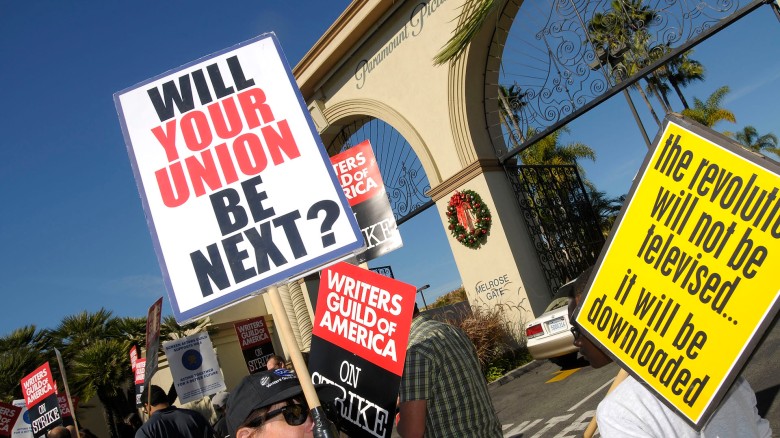
The WGA could go on strike against the studios if a deal is not reached by May 1. Learn what they’re fighting for.
If the Writers Guild of America (WGA) and the Alliance of Motion Picture and Television Producers (AMPTP) fail to reach a minimum bargaining agreement May 1, Hollywood is days away from what could be a massive disruption to the film and TV industry. Writers say they want a living wage as streaming devalues their work even as it demands more of their time. Studios say the guild is asking too much at the wrong time — streaming has to focus on revenue when it used to value subscriber counts.
There’s a lot more to it than that, of course. No one “wants” a strike, but ahead of the guild’s contract expiring May 1, the clock is ticking fast, both sides are digging their heels in, and there’s little optimism that a work stoppage of some kind won’t happen.
In recent weeks, IndieWire approached the writer’s strike from the ground level, speaking to writers from different backgrounds — including a feature film writer, a narrative TV writer for both broadcast and streaming, and a veteran late night comedy writer — each of whom faces different challenges. Here’s what’s at stake, how we got here, how long a strike could last, and what it all means.
What happened ahead of the May 1 deadline?
On April 17, WGA members overwhelmingly approved a strike authorization vote, which gives the guild permission from its over 11,500 television and movie writers to initiate a strike if the two sides can’t make a deal. That strike authorization vote was approved by 97.78 percent of the members who voted, a record for the guild in terms of unity but also in terms of members who submitted ballots. It gives the guild a lot of leverage in the remaining days of talks with the AMPTP and proves they mean business.
Back during 2017’s negotiations, there was a similar vibe around town and the strike authorization vote approval was nearly as high… but the guild and the studios averted a strike at the last minute. That could still happen here.
In the last few months, producers began stockpiling scripts. Studios greenlit projects and raced to begin production while pitches for other new business dwindled and the market slowed. Not great signs.
So what happened the last time the writers went on strike?
Back in 2007, the WGA fought for regulated payment over content moving to “new media,” i.e. streaming before anyone knew to call it streaming. At that point, Netflix was a DVD company that had just introduced streaming, but enough content lived online that writers knew they had to make a move. In the 100-day work stoppage that extended into February 2008, talk shows and other variety shows ground to a halt. TV series like “30 Rock,” “The Big Bang Theory,” or “Heroes” saw their seasons cut short, while others like “24” or “Entourage” were delayed altogether.
It meant a whole lot of reruns, reality shows, and game shows. Some late-night hosts found ways to keep their non-writing staffs paid for a period of time; some late-night shows returned to the air without writers until the strike was resolved. A 2008 report in the Los Angeles Times estimated that the strike cost the local economy $2.1 billion and that didn’t take into account all the ripple effects on other industries nationwide or the impact it had on individual crew members.
What was the outcome of the last strike?
After the strike, streamers were obligated to hire WGA writers and writers received 1.2% of a distributor’s gross receipts for rentals. For ad-supported streaming, writers were granted 2% of gross receipts after the first 17 days. Attempts to place reality and animation writers under the WGA failed. There was no determination around subscription-based streaming because, at the time, it barely existed.
“Abbott Elementary”
ABC
What could happen to the movies and shows I watch today?
If a strike begins, it will mean writing work will immediately halt for movies, television, and streaming. Just as before, late-night talk shows would almost instantly stop producing new episodes and variety shows like “Saturday Night Live” or “Last Week Tonight” would be forced to cut their seasons short.
While many of the highest-profile broadcast or cable series are already in the can, it might not take long before viewers notice an impact and see the fall season and returns of shows delayed, as writers generally begin work on the season in May or June. The WGA last week sent a letter to media analysts and investors (read it here) indicating that during the 2007-08 strike, almost 25 percent of all primetime, scripted programming during that network season was lost, and it singled out shows like “Abbott Elementary,” “NCIS,” or “Chicago Med” that could be delayed.
Largely unaffected would be reality shows, game shows, news, sports, and other unscripted programming. Streamers also have an advantage studios have more leverage now than they did in 2007, it’s because there are more avenues now for streamers to lean on international programming that are outside the WGA. IndieWire even reported that a recent dip in the market for documentary films and series could see a renewed surge of interest if networks and streamers are forced to turn to more unscripted documentaries for content.
With movies, the impacts could be felt not this year but next year, should projects that are in the pipeline now get delayed or are not able to start shooting on schedule because of a work stoppage. The longer a strike goes, the more pronounced those problems become.
Compared to 2007, what’s different for the studios facing a writers’ strike?
It’s possible that they may feel less pressure, initially: Sixteen years ago, streaming was in its infancy and viewing options were much more limited. The constant feed of on-demand content means no one faces the same kind of rerun exhaustion
That said, there’s still the problem of no TV shows and movies drive, which drive subscribers and retention. All streamers are reckoning with revenue and the reality that making money with these resource-intensive platforms is more challenging than it initially appeared.
Much of the broadcast or cable content people watch the next day on streamers like Hulu, Peacock, or Paramount+ would be affected by any delays to the broadcast season, and that also could impact on a streamer’s subscriber growth and bottom line. Many streamers though, most notably Netflix, will be able to weather the storm for longer with slates planned out months in advance.
What do writers want?
Writers are demanding higher wages that can keep up with inflation, content spends, and company profits. A streaming boom lead to waves of content, but writers feel they are being asked to do more for less. Ahead of negotiations, the WGA said median weekly pay for writers-producers has declined four percent over the last decade; adjusted for inflation, the decline is 23 percent. The median number of working weeks for TV staff writers, showrunners, and screenwriters has increased, even though the number of episodes on an average season has dropped from roughly 21 episodes in the old days to eight to 12 episodes today. Writers who are paid per episode saw their average pay dwindle — sometimes to at minimum wage, if not below.

WGA West building
Getty Images
Many writers rely on residuals from their work being re-aired or distributed as a long-term source of income, but these are also evaporating. The dominance of streaming means fewer TV episodes available; for programming like reality shows or variety, late night, and talk shows produced for streaming, the residuals range from inconsistent to nonexistent. In film, residuals have all but disappeared as streamers hold on to their content; there’s no afterlife in syndication, cable, or DVDs.
Another trend WGA wants to rein in is the “mini-room” in which a group of writers come up with stories for a full season of a show before hiring a full writing staff. This format can allow a singular writer or showrunner to hatch a show’s entire arc, but as one mini-room writer recently explained to IndieWire, in practice it means writers do the full amount of work for far less pay. If they develop storylines well in advance, a streamer or network may only have to pay if the show is picked up to a second season.
And then there’s the AI question. The technology is in its infancy, but the guild sees how studios might view AI as the screenwriting workhorse they’ve always wanted. AI-generated material often bases its results on guild-protected, copyrighted material, but that work emerges without credit or payment. The guild is fighting to make sure AI can’t be used to rewrite a script or that a robot can’t be covered by the guild’s bargaining agreement.
What can writers do during the strike?
The WGA released a long and detailed list of what writers can’t do when a strike begins, including write for or deliver scripts and negotiate or discuss projects. They’re required to request the return of spec scripts, tell their agents not to negotiate for them, honor picket lines and tell the WGA of an y strikebreaking activity.
What about the other guilds?
The Directors Guild and the Screen Actors Guild each have contracts that expire June 30. DGA members support the strike but have a “no-strike” clause in their own contract that requires them to still come to work and cross a picket line, even if other guilds go on strike. The Teamsters have said that they will not cross picket lines. Also supporting the strike are IATSE, SAG-AFTRA, and the Art Directors Guild.
What is the studio’s side in of all this?
Writers will point to soaring executive pay, massive investments, content spending, production budgets, and annual profits and say: Why aren’t we seeing that money? The massive corporations have their challenges: For Disney, Paramount, and Warner Bros. Discovery, their flagship streaming services aren’t yet profitable despite the years they’ve spent chasing subscribers. Disney is in the midst of laying off 7,000 employees, and they’re following other hundreds or thousands of layoffs and re-organizations from their rivals. Streamers like Netflix and Amazon are tightening their belts and not increasing their content spending; the global box office is still far below its pre- pandemic performance. So maybe now is not the ideal time to fighting for money, but as the guild has learned through painful experience: It never is.
Sign Up: Stay on top of the latest breaking film and TV news! Sign up for our Email Newsletters here.














